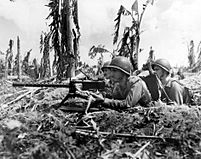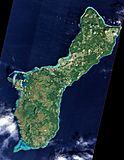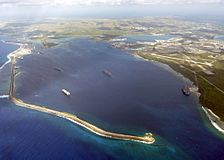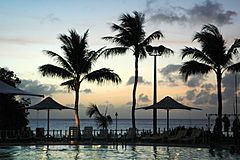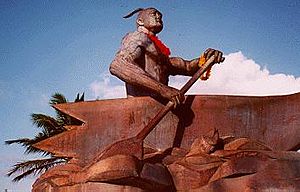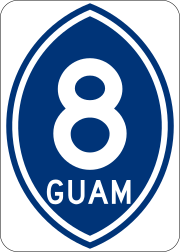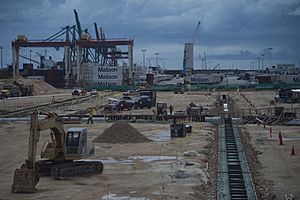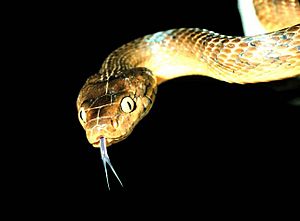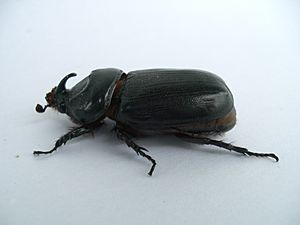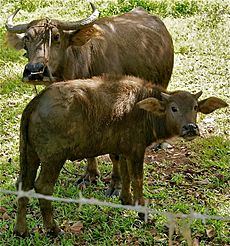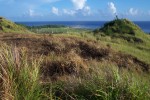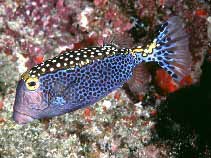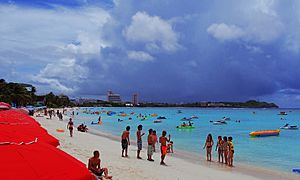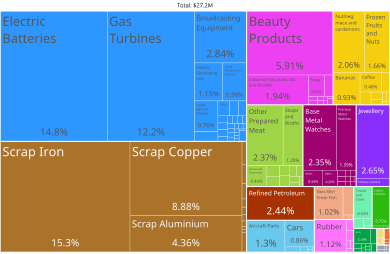Guam facts for kids
Quick facts for kids
Guam
Guåhan
|
|||
|---|---|---|---|
|
|||
| Nickname(s): | |||
| Motto(s): | |||
| Anthem: "Stand Ye Guamanians" | |||
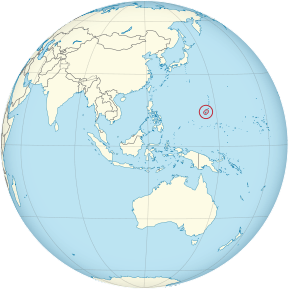
Location of Guam (circled in red)
|
|||
| Sovereign state | |||
| Before annexation | Spanish East Indies | ||
| Cession from Spain | April 11, 1899 | ||
| Capital | Hagåtña | ||
| Largest city | Dededo | ||
| Official languages | |||
| Ethnic groups
(2010)
|
|||
| Religion
(2010)
|
|
||
| Demonym(s) | Guamanian | ||
| Government | Devolved presidential constitutional dependency within a Federal republic | ||
| Joe Biden (D) | |||
|
• Governor
|
Lou Leon Guerrero (D) | ||
|
• Lieutenant Governor
|
Josh Tenorio (D) | ||
| Legislature | Legislature of Guam | ||
| Area | |||
|
• Total
|
540 km2 (210 sq mi) | ||
| Highest elevation | 407 m (1,334 ft) | ||
| Population | |||
|
• 2021 estimate
|
168,801 (177th) | ||
|
• Density
|
299/km2 (774.4/sq mi) | ||
| GDP (PPP) | 2016 estimate | ||
|
• Total
|
$5.79 billion | ||
|
• Per capita
|
$35,600 | ||
| GDP (nominal) | 2019 estimate | ||
|
• Total
|
US$6.311 billion | ||
|
• Per capita
|
$37,387.22 | ||
| HDI (2017) | very high |
||
| Currency | United States dollar (US$) (USD) | ||
| Time zone | UTC+10:00 (ChST) | ||
| Date format | mm/dd/yyyy | ||
| Driving side | right | ||
| Calling code | +1-671 | ||
| USPS abbreviation |
GU
|
||
| ISO 3166 code |
|
||
| Internet TLD | .gu | ||
Guam is a special U.S. territory located in the western Pacific Ocean. It is the westernmost point of the United States. Guam is the largest and southernmost island in the Mariana Islands. It is also the biggest island in Micronesia.
The capital city of Guam is Hagåtña. The most populated village is Dededo. People born on Guam are American citizens. However, they cannot vote in U.S. presidential elections if they live on Guam. Also, Guam's representative in the United States House of Representatives cannot vote on the floor.
The native people of Guam are called the Chamoru. They are related to Austronesian groups from places like Indonesia and the Philippines. In 2021, Guam's population was about 168,801. Chamorus are the largest group, but many other ethnic groups live on the island. Guam is about 540 square kilometers (210 square miles) in size.
The Chamoru people first settled on the island around 3,500 years ago. The first European to visit Guam was Ferdinand Magellan in 1521. Spain then colonized Guam in 1668. For centuries, Guam was an important stop for Spanish ships called Manila Galleons. These ships traveled across the Pacific Ocean.
During the Spanish–American War, the United States took control of Guam in 1898. Spain officially gave Guam to the U.S. in 1899. Before World War II, Guam was a key U.S. location in the Pacific. In December 1941, Japan captured Guam. Japanese forces occupied the island for two and a half years. During this time, Guamanians faced forced labor and other hardships.
American forces recaptured the island on July 21, 1944. This day is now celebrated as Liberation Day. Since the 1960s, Guam's economy has grown. It is mainly supported by tourism and the U.S. military. Guam is a very important strategic location for the U.S. military.
Guam has an unofficial motto: "Where America's Day Begins." This refers to its location near the International Date Line. Guam is listed by the United Nations as a non-self-governing territory. It has been part of the Pacific Community since 1983.
Contents
Guam's History
The first people on Guam were likely descendants of Austronesian people. They came from Southeast Asia around 2000 BC. These early settlers became the Chamorro people.
Ancient Chamoru society had different social classes. The chamorri were chiefs, and the matua were the upper class. The mana'chang were the lower class. People also believed in spirits of ancient Chamorus called "Taotao mo'na." Chamoru society was organized around matrilineal clans. This means family lines were traced through mothers.
Latte stones are stone pillars found only in the Mariana Islands. They were used as foundations for thatched huts. These stones have a base called a haligi and a capstone called a tåsa. A quarry for these stones was found on Rota in 1925.
First European Contact
The first European to see Guam was Ferdinand Magellan. He was a Portuguese explorer sailing for Spain. He sighted the island on March 6, 1521, during his trip around the world.
When Magellan arrived, he saw many fast outrigger canoes. He called Guam Islas de las Velas Latinas, meaning "Islands of the Lateen sails." One of Magellan's crew, Antonio Pigafetta, also called it the "Island of Sails." However, he noted that the people took things from their ships. Because of this, Magellan also called the islands Islas de los Ladrones, or "Islands of Thieves."
Spanish Rule and Trade
Spain did not officially claim Guam until 1565. This was done by General Miguel López de Legazpi. From 1565 to 1815, Guam was a key stop for the Manila galleons. These Spanish ships traded between Acapulco (Mexico) and Manila (Philippines).
To protect these ships, Spain built forts on Guam. One example is Fort Nuestra Señora de la Soledad in Umatac. Guam is the largest island between Kyushu (Japan), New Guinea, the Philippines, and the Hawaiian Islands.
Spanish colonization began on June 15, 1668. Diego Luis de San Vitores and Pedro Calungsod arrived and built the first Catholic church. Guam was part of the Spanish East Indies. This area was governed from the Philippines, which was part of Viceroyalty of New Spain (Mexico).
Other Spanish colonial reminders include the old Governor's Palace in Plaza de España. The Spanish Bridge in Hagåtña is another example. Guam's Cathedral Dulce Nombre de Maria opened in 1669. Guam's Chamoru culture has native roots. However, it also shares many similarities with Spanish and Mexican cultures. This is due to three centuries of Spanish rule.
Challenges and Changes
From 1670 to 1695, there was fighting on the island. Typhoons and a smallpox epidemic also greatly reduced the Chamoru population. The population dropped from 50,000 to less than 5,000. These conflicts began after the death of Quipuha and the murder of Father San Vitores.
Spanish leaders worked to bring peace to the island. Captain Juan de Santiago started a campaign, and later Captain Damian de Esplana ordered arrests of rebels. Villages were destroyed during these times. In 1676, Captain Francisco de Irrisarri y Vinar became the first Spanish Governor of Guam. He built schools, roads, and other important structures.
Captain Jose de Quiroga arrived in 1680. He continued development projects and searched for rebels. He brought natives from northern islands to Guam. He also ordered people to live in larger villages like Umatac and Agat. By 1695, Quiroga had brought peace to Guam and nearby islands.
In 1767, Charles III of Spain ordered the Jesuits to leave Spanish lands. The Jesuit priests on Guam left in 1769. They left behind their churches and properties.
Governor Don Mariano Tobias arrived in 1771. He brought many changes to farming. He made land available for islanders to grow crops. He also encouraged raising cattle and imported animals like deer and water buffalos. He set up cotton mills, salt pans, free public schools, and the first Guam militia.
Modern Era and Wars
After the Napoleonic Wars, many Spanish colonies became independent. This shifted Guam's economy from Mexico to the Philippines. Governor Don Francisco Ramon de Villalobos improved economic conditions in 1831. He promoted rice farming and built a hospital for people with leprosy.
Many explorers visited Guam in the 1800s, including Otto von Kotzebue and Louis de Freycinet. The island became a stop for whalers starting in 1823. A strong typhoon hit Guam in 1848, followed by an earthquake in 1849. A smallpox epidemic in 1856 killed many Guamanians. After this, people from the Caroline Islands and Japan were allowed to settle in the Marianas.
Spanish-American War
The United States took control of Guam during the 1898 Spanish–American War. This was part of the Treaty of Paris. Guam was given to the U.S. Navy in December 1898. It became a station for American ships traveling to the Philippines. Meanwhile, Spain sold the Northern Mariana Islands to Germany.
A U.S. Navy yard was built in Piti in 1899. A marine barracks was built in Sumay in 1901. After the Philippine–American War, leaders like Emilio Aguinaldo were exiled to Guam in 1901.
World War II
A marine seaplane unit was on Guam from 1921 to 1930. Pan American Airways built a seaplane base for its flights to Manila and Hong Kong. The Commercial Pacific Cable Company also built a telegraph station in 1903.
During World War II, Japan attacked and invaded Guam on December 8, 1941. This happened shortly after the attack on Pearl Harbor. The Northern Mariana Islands were controlled by Japan since 1919. Chamorros from the Northern Marianas helped the Japanese forces on Guam. They acted as interpreters.
Guamanian Chamorros were treated as enemies by the Japanese military. After the war, this caused some tension between the two groups. Guam's Chamorros felt their northern relatives should have been more understanding. However, the Northern Mariana Chamorros had been loyal to Japan for over 30 years.
The Japanese occupation of Guam lasted about 31 months. During this time, native Guamanians faced forced labor and other harsh treatments. About 1,000 people died during the occupation. Some historians believe war violence killed 10% of Guam's 20,000 people.
The United States returned and fought the Battle of Guam from July 21 to August 10, 1944. They recaptured the island from Japan. More than 18,000 Japanese soldiers died. Sergeant Shoichi Yokoi was the last Japanese soldier to surrender in Guam in 1972. The U.S. also took control of the Northern Marianas.
North Field was built in 1944. It was later renamed Andersen Air Force Base after Brigadier General James Roy Andersen.
After the War
After World War II, the Guam Organic Act of 1950 was passed. This law made Guam an organized territory of the United States. It set up Guam's civilian government and gave U.S. citizenship to its people. The Governor of Guam was appointed by the U.S. government until 1968. Then, the Guam Elective Governor Act allowed people to elect their governor.
Since Guam is not a U.S. state, its citizens cannot vote for president. Their representative in Congress also cannot vote on laws. However, they can vote for party delegates in presidential primaries.
Andersen Air Force Base was very important during the Vietnam War. It is now home to the 36th Wing. The multinational Cope North military exercise happens there every year.
In 1997, Korean Air Flight 801 crashed on Guam. The plane was landing when it hit a hill. 228 of the 254 people on board died. Since 1974, about 124 historic sites in Guam have been recognized. These sites are listed on the U.S. National Register of Historic Places. Guam also temporarily hosted many refugees. This included 100,000 Vietnamese refugees in 1975 and 6,600 Kurdish refugees in 1996.
Guam's Geography
Guam is located between 13.2°N and 13.7°N latitude and 144.6°E and 145.0°E longitude. It covers an area of about 549 square kilometers (212 square miles). This makes it the 32nd largest island in the United States. It is the southernmost and largest island in the Mariana Islands chain. It is also the biggest island in Micronesia.
The Mariana island chain was formed when the Pacific and Philippine Sea tectonic plates collided. Guam is very close to the Mariana Trench. This is a very deep ocean area next to the island chain. Challenger Deep, the deepest point in the Oceans, is southwest of Guam. It is about 10,911 meters (35,797 feet) deep. The highest point on Guam is Mount Lamlam, which is 407 meters (1,334 feet) high.
Guam is about 48 kilometers (30 miles) long and 6 to 19 kilometers (4 to 12 miles) wide. It is about three-quarters the size of Singapore. The island sometimes has earthquakes. This is because it is on the edge of the Pacific Plate and near the Philippine Sea Plate. Earthquakes near Guam have ranged from 5.0 to 8.7 in strength.
Unlike the Anatahan volcano in the Northern Mariana Islands, Guam does not have active volcanoes. However, volcanic smog, called vog, can sometimes reach Guam from Anatahan.
A coral reef surrounds most of Guam. The island's limestone plateau provides most of its fresh water. The northern part of Guam has steep coastal cliffs. The southern part is mountainous, with lower hills in between.
Guam's Climate
Guam has a tropical marine climate. This means it is generally warm all year with little change in temperature. Seasonal easterly trade winds help moderate the weather. The average high temperature is 30°C (86°F), and the average low is 24°C (76°F). Guam gets about 2,438 millimeters (96 inches) of rain each year. Temperatures rarely go above 32°C (90°F) or below 21°C (70°F).
The air is often humid, especially at night. The dry season runs from December to June. The wet season is from July to November. January and February are the coolest months. The highest temperature ever recorded was 36°C (96°F) in April 1971 and April 1990. The lowest was 18°C (65°F) in February 1973.
Guam is in "Typhoon Alley." This means it is often threatened by tropical storms and typhoons during the wet season. The highest risk of typhoons is from August to October. However, they can happen any time of year. Super Typhoon Pongsona hit Guam on December 8, 2002. It had winds of 232 km/h (144 mph) and caused a lot of damage.
Since Super Typhoon Pamela in 1976, most wooden buildings have been replaced with concrete ones. Utility poles are now made of concrete and steel to resist typhoons. Many homes and businesses are built with reinforced concrete and have typhoon shutters.
Guam's People
| Historical population | |||
|---|---|---|---|
| Census | Pop. | %± | |
| 1910 | 11,806 | — | |
| 1920 | 13,275 | 12.4% | |
| 1930 | 18,509 | 39.4% | |
| 1940 | 22,290 | 20.4% | |
| 1950 | 59,498 | 166.9% | |
| 1960 | 67,044 | 12.7% | |
| 1970 | 84,996 | 26.8% | |
| 1980 | 105,979 | 24.7% | |
| 1990 | 133,152 | 25.6% | |
| 2000 | 154,805 | 16.3% | |
| 2010 | 159,358 | 2.9% | |
| 2020 | 153,835 | −3.5% | |
According to the 2010 United States Census, the largest ethnic group is the native Chamorus. They make up 37.3% of the population. Asians, including Filipinos, Koreans, Chinese, and Japanese, are 33% of the population. Other groups from Micronesia make up 10%. About 9.4% of people are multiracial, and White Americans are 7.1%. Many people on Guam are from mixed ethnic backgrounds.
The official languages are English and Chamoru. Filipino is also widely spoken. Other Pacific and Asian languages are used too. Spanish was the official language for 300 years. However, it is not commonly spoken today. Some Spanish words are still found in names and places.
Most people on Guam are Christian. About three-quarters of the population are Roman Catholic. Most of the rest belong to Protestant churches. According to the Pew Research Center in 2010, the religious groups were:
- Roman Catholicism: 75%
- Protestantism: 17.7%
- Other religions: 1.6%
- Folk religions: 1.5%
- Other Christianity: 1.4%
- Buddhism: 1.1%
- Eastern Orthodoxy: <1%
- Hinduism: <1%
- Islam: <1%
- Judaism: <1%
Guam's Culture
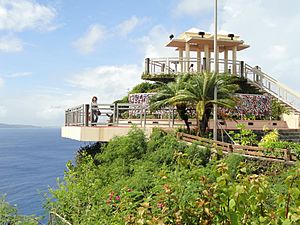
Modern Chamorro culture on Guam is a mix of American, Spanish, Filipino, and other Micronesian traditions. There are only a few original pre-Hispanic customs left. These influences can be seen in the language, music, dance, food, and games. During Spanish rule (1668–1898), most people became Roman Catholic. Religious holidays like Easter and Christmas became very important.
Chamorro food today often uses corn. Examples include tortillas and tamales, showing Spanish and Mexican influences. The modern Chamorro language is a Malayo-Polynesian language with many Spanish words. Many Chamorros also have Spanish surnames. This happened when they converted to Catholicism and adopted new names.
Most of the early native culture was lost due to foreign influences. However, there has been a recent effort to save what remains of pre-Hispanic culture. Scholars have studied other Pacific Islands to learn about original Chamorro dance, language, and canoe building.
Two important parts of pre-Hispanic culture that still exist are chenchule and inafa'maolek. Chenchule is a system of giving and receiving help in Chamorro society. It is based on the idea of inafa'maolek, which means interdependence. Historian Lawrence Cunningham explained in 1992 that in Chamorro culture, land and its products belong to everyone. Inafa'maolek relies on cooperation and sharing. It is about working together instead of focusing on just one person.
The core Chamorro culture, or Pengngan Chamorro, is based on respect. This includes sniffing the hands of elders (called mangnginge). It also involves passing down legends and courtship rituals. People might even ask spirits for permission before entering a jungle. Other old practices include making galaide' canoes. They also made the belembaotuyan, a musical instrument from a gourd. People used åcho' atupat slings and slingstones for hunting. They also had special burial rituals and used herbal medicines.
Skilled craftspeople create woven items. These include baskets, mats, and hats from coconut and pandan leaves. They also make loom-woven skirts and belts from plant fibers. Body ornaments like necklaces and bracelets are made from shells.
Today, Guam is a mix of many cultures. This makes it hard for Chamorros to keep their unique culture and identity. Many young Chamorros are moving to the U.S. Mainland. This also makes it harder to define and preserve Chamorro identity. While few masters of traditional arts remain, more young Chamorros are now trying to learn and continue the ancient ways.
Guam's Villages
Guam is divided into 19 areas called villages:
Transportation and Communication
Most of Guam has modern mobile phone services and fast internet. You can get internet through cable or DSL. In 1997, Guam joined the North American Numbering Plan. This made calls to the U.S. mainland much cheaper.
Guam is also a major hub for underwater cables. These cables connect the western U.S., Hawaii, Australia, and Asia. Guam has 12 submarine cables. This means the island has "tremendous bandwidth" and internet prices similar to the U.S. mainland.
In 1899, Guam used special postage stamps. But soon after, regular U.S. postage stamps were used. Guam is part of the U.S. Postal System. Its postal abbreviation is GU, and ZIP codes range from 96910 to 96932. Mail from the U.S. mainland to Guam is considered domestic. This means there are no extra charges. However, private shipping companies like FedEx do not always treat Guam as domestic.
Mail delivery times vary. Small, first-class items usually take less than a week. Larger items can take one to two weeks. Fourth-class mail, like magazines, travels by sea after reaching Hawaii. Most residents use post office boxes. However, home delivery is becoming more common. If sending mail from outside the Americas, address it to "Guam" instead of "USA." This helps avoid delays and higher costs.
The Port of Guam is vital for the island. Most products are shipped into Guam for people to buy. The port receives weekly calls from the Matson shipping line. These ships connect Guam with Honolulu, Los Angeles, Oakland, and Seattle. The port is also a hub for shipping goods to over 500,000 customers in the Micronesian region. It handles containers for U.S. military bases on the island.
Guam is served by the Antonio B. Won Pat International Airport. The island is outside the U.S. customs zone. So, Guam has its own customs and quarantine agency. The U.S. Customs and Border Protection only handles immigration checks. Since Guam is under federal immigration rules, travelers from the U.S. go straight to Guam Customs.
However, there is a special visa waiver program for some countries. This means pre-clearance checks are done on Guam for flights to the U.S. For travel from the Northern Mariana Islands to Guam, a passport and visa check is done before the flight. No immigration check is needed for flights from Guam to the Northern Mariana Islands. If you travel between Guam and the U.S. through a foreign country, you will need a passport.
Most residents use their own cars to get around Guam. The Guam Regional Transit Authority offers bus services. Some companies also run buses for tourists.
Ecological Issues
Brown Tree Snake Invasion
The brown tree snake (Boiga irregularis) was accidentally brought to Guam. It is believed to have arrived as a stowaway on a U.S. military transport during World War II. Guam had no native snakes before this. The snake has almost wiped out the island's native bird population. This problem is worse because the snake has no natural predators on Guam.
The brown tree snake, called kulebla locally, comes from Australia, Papua New Guinea, and the Solomon Islands. It is slightly venomous but usually harmless to humans. It is active at night. Even though there are many snakes on Guam, residents rarely see them. The United States Department of Agriculture uses special dogs to find snakes in cargo. The United States Geological Survey also uses dogs to find snakes in forests.
Before the brown tree snake arrived, Guam had several unique bird species. These included the Guam rail (or ko'ko bird) and the Guam flycatcher. Both were common. Today, the flycatcher is completely gone. The Guam rail is extinct in the wild but is bred in captivity. The snake has caused huge damage over decades. Up to 12 bird species are believed to have disappeared. Many elders say ko'ko birds were common before World War II.
Other birds threatened by the brown tree snake include the Mariana crow and the Mariana swiftlet. Guam is said to have many more insects and spiders than nearby islands. This is because there are fewer birds to eat them. The forests are also very quiet due to the lack of birdsong.
Coconut Rhinoceros Beetle
An infestation of the coconut rhinoceros beetle (CRB) was found on Guam in September 2007. This beetle is not usually found in the United States, except in American Samoa. Surveys showed the infestation was limited to Tumon Bay and Faifai Beach. This area is about 364 hectares (900 acres). The Guam Department of Agriculture placed a quarantine on properties in the Tumon area. The CRB is native to Southern Asia.
Other Invasive Animals
From the 1600s to 1800s, the Spanish brought pigs, dogs, chickens, Philippine deer, and carabao (a type of water buffalo) to Guam. These animals have cultural meaning. However, herds of carabao can interfere with military base operations and harm native plants. The U.S. military began reducing the herds in 2002, which led to protests.
Other introduced species include cane toads, brought in 1937. The giant African snail is an agricultural pest. It was brought by Japanese troops during World War II. More recently, frog species have arrived. These could harm crops and provide more food for the brown tree snake. Reports of loud chirping frogs, called coquí, have raised fears. They may have come from Hawaii.
Wild pigs and deer, too much hunting, and habitat loss from human development also harm Guam's native plants and animals.
Threats to Native Plants
Invading animals are not the only threat to Guam's native plants. Tinangaja, a virus that affects coconut palms, was first seen in 1917. At that time, coconut production was a big part of Guam's economy. Today, there are no coconut plantations. However, dead and infected trees are seen throughout Guam's forests.
Over the last century, the thick forests of northern Guam have been replaced by tangan-tangan brush (Leucaena leucocephala). Much of Guam's trees were lost during World War II. In 1947, the U.S. military may have planted tangan-tangan from the air to stop erosion. Tangan-tangan was on the island before 1905.
In southern Guam, non-native grass species cover much of the land. The colorful flame tree (Delonix regia) is found in the Marianas. However, many of these trees on Guam have been destroyed.
Wildfires
Wildfires happen in Guam's forests every dry season. This is true even though the island has a humid climate. Most fires are caused by people, with 80% being arson. Poachers often start fires to attract deer to new plant growth. Invasive grass species that need fire to grow are found in many burned areas.
Grasslands have replaced forests. This leads to more soil erosion. During the rainy season, heavy rains carry soil into the Fena Lake Reservoir and Ugum River. This causes water quality problems for southern Guam. Eroded soil also harms marine life in the reefs. Efforts to stabilize soil by planting trees have not been very successful.
Aquatic Preserves
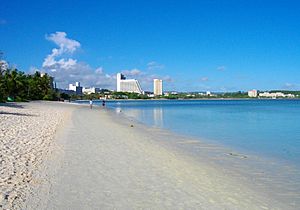
People are working to protect Guam's coral reefs. These habitats are threatened by pollution, eroded silt, and overfishing. These problems have led to fewer fish. Guam is a popular spot for scuba divers, so protecting the reefs is important.
The Department of Agriculture has created several new marine preserves. Biologists monitor fish populations in these areas. Before U.S. Environmental Protection Agency standards, parts of Tumon Bay were dredged by hotels. This was done to make the beach better for guests. Tumon Bay is now a preserve. A federal Guam National Wildlife Refuge in northern Guam protects the sea turtle population. It also protects a small group of Mariana fruit bats.
Harvesting sea turtle eggs was common on Guam before World War II. The green sea turtle (Chelonia mydas) was legally harvested until 1978. Then, it was listed as threatened under the Endangered Species Act. The hawksbill sea turtle (Eretmochelys imbricata) has been on the endangered list since 1970. To protect sea turtles, sightings are counted during aerial surveys. Nest sites are also monitored for hatchlings.
|
|
|
|
|---|
Guam's Economy
Guam's economy mainly relies on tourism, U.S. military bases, and local businesses. A special law by Congress allows Guam's treasury to receive federal income taxes paid by local taxpayers. This includes military and federal employees on Guam.
Tourism in Guam
Guam is a popular place for Japanese tourists. Its main tourist area, Tumon, has over 20 large hotels. It also has a Duty Free Shoppers Galleria and Pleasure Island district. There is an indoor aquarium and Las Vegas-style shows. Guam is a short flight from Asia or Australia compared to Hawaii. It has hotels and seven public golf courses. Over a million tourists visit each year.
Most tourists (75%) are Japanese. However, many also come from South Korea, the U.S., the Philippines, and Taiwan. Important sources of money come from duty-free designer shops. American-style malls like Micronesia Mall and Guam Premier Outlets also bring in money. Guam has the world's largest Kmart.
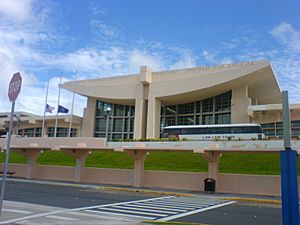
Guam's economy has been stable since 2000 due to more tourism. It was expected to grow with the transfer of U.S. Marines from Japan to Guam. This move was delayed until late 2020. The number of Marines was reduced to 5,000. In 2003, Guam had a 14% unemployment rate. The government also had a $314 million budget shortfall. By 2019, unemployment dropped to 6.1%. However, by September 2020, it rose again to 17.9%.
The Compact of Free Association allows citizens from the Federated States of Micronesia, the Marshall Islands, and Palau to live in the U.S. and its territories. Many moved to Guam because it was close and familiar. Some people in Guam felt the territory had to pay for public assistance and education for these migrants. They believed the federal government should help. Congress has given "Compact Impact" aid to Guam, the Northern Mariana Islands, and Hawaii. This aid is now part of the renewed Compacts.
As of 2008, Guam's largest private employer was Continental Micronesia. It was a part of Continental Airlines and is now part of United Airlines. It provided about 1,400 jobs.
Military Bases in Guam
Currently, Joint Region Marianas manages military bases that cover about 15,787 hectares (39,000 acres). This is 29% of the island's total land area. These bases include:
- U.S. Naval Base Guam, U.S. Navy (Santa Rita)
- Andersen Air Force Base, U.S. Air Force (Yigo)
- Marine Corps Base Camp Blaz, U.S. Marine Corps (Dededo)
- Ordnance Annex, U.S. Navy (South Central Highlands)
- Naval Computer and Telecommunications Station Guam, U.S. Navy (Dededo)
- Naval Radio Station Barrigada (Barrigada)
- Joint Region Marianas Headquarters (Asan)
- Naval Hospital Guam (Agana Heights)
- South Finegayan (Dededo), a military housing area
- Andersen South (Yigo), which was once Marine Barracks Guam
- Fort Juan Muña, Guam National Guard (Tamuning)
The U.S. military planned to build a new aircraft carrier berth on Guam. They also planned to move 8,600 Marines and their families from Japan to Guam. This would have increased Guam's population by 49%. In 2010, the United States Environmental Protection Agency criticized these plans. They worried about water shortages, sewage problems, and harm to coral reefs. As of 2022, the Marine Corps plans to place 5,000 Marines on the island by the mid-2020s.
Education in Guam
The Guam Public Library System runs the Nieves M. Flores Memorial Library in Hagåtña. It also has five branch libraries.
The Guam Department of Education serves all of Guam. In 2000, 32,000 students attended public schools. This included 26 elementary schools, eight middle schools, and six high schools. Guam's public schools have faced challenges like high dropout rates and low test scores. It is hard for Guam's education system as a small community far from the U.S. mainland. Many students come from different educational backgrounds. An economic downturn since the mid-1990s has made school problems worse.
Before 1997, the U.S. Department of Defense worked with the Guam Board of Education. In September 1997, the Department of Defense Education Activity (DoDEA) opened its own schools. These schools are for children of military personnel and some federal employees. In 2000, about 2,500 students attended DoDEA schools. DoDEA Guam has three elementary/middle schools and one high school.
The University of Guam (UOG) and Guam Community College offer higher education. Both are fully accredited. UOG is one of only 106 land-grant institutions in the U.S. Pacific Islands University is a small Christian liberal arts school.
Images for kids
-
Main street of Hagåtña ca. 1899-1900
-
U.S. Marines walk through the ruins of Hagåtña, July 1944
-
Photograph of Guam from space captured by NASA's now decommissioned Earth observation satellite, Earth Observing-1 (EO-1), on December 30, 2011
-
The introduction of the brown tree snake nearly eradicated the native bird population
-
The Guam Museum in Hagåtña opened in 2016
See also
 In Spanish: Guam para niños
In Spanish: Guam para niños




